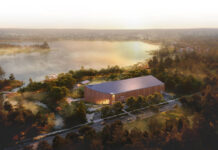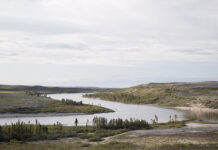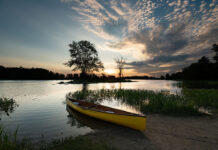A west wind blowing across Little Lake delivers a steady chop into the thin beach on the east shoreline. Just inland, four midsize white pines have created a small clearing underneath. Jeremy Ward remarks on how the flat carpet of pine needles would make a good campsite and Carolyn Hyslop agrees, noting the trees are perfectly spaced for a few hammocks.
It’s easy to imagine a canoe overturned on the beach and a campfire crackling. A far greater imaginative feat would have been to look at this former woodlot on the edge of the small city of Peterborough, Ontario, and envision it as the site of a marquee museum and draw for 87,000 visitors a year. And yet, three years and $40 million later, the Canadian Canoe Museum is about to move into a new home showcasing and celebrating the world’s largest collection of canoes and kayaks.
But to say the process took only three years would be a gross understatement.
From its inception as the private collection of summer camp director Kirk Wipper in the 1950s, to its years on occasional life support in a vacated outboard motor factory, to a gut-wrenching about-face during initial relocation plans, the job of running a niche museum has never been easy. But with the May 11, 2024, grand opening coming into view, two individuals at the center of what one past executive director has called a “triumph of leadership” are eager to show off the new museum.
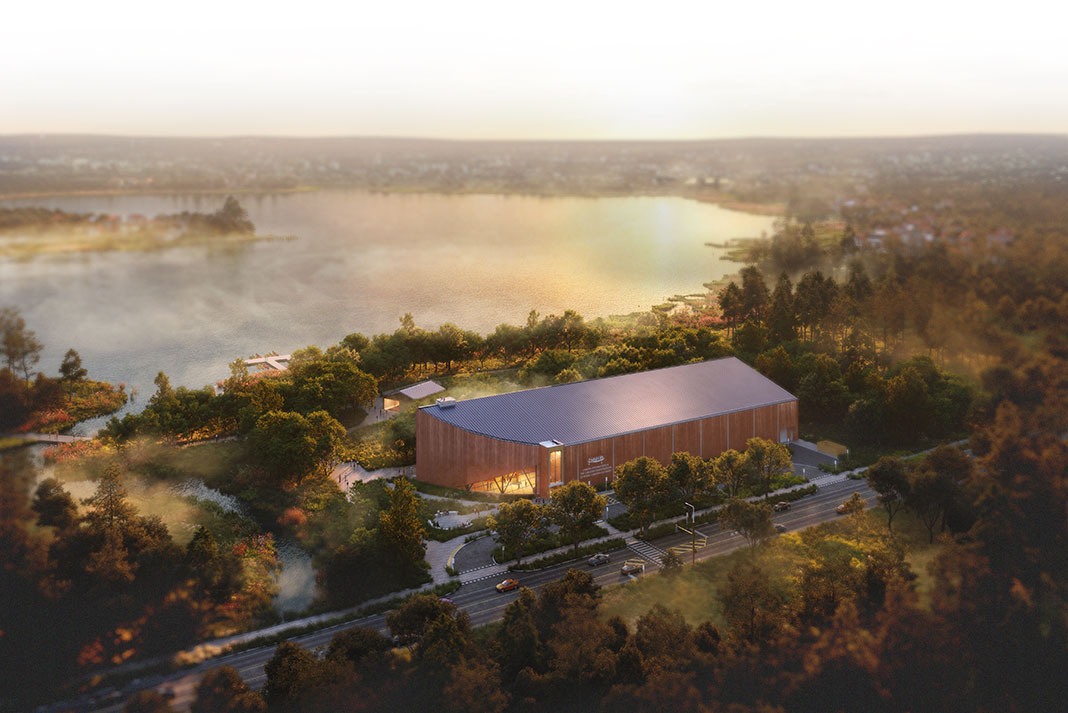
Building a bigger, better Canadian Canoe Museum
Recently, when not on-site overseeing the construction of a major large-artifact museum, executive director Carolyn Hyslop and curator Jeremy Ward were plenty busy trying to run the Canadian Canoe Museum in the site it had occupied in south Peterborough since 1997.
The 1960s-era location cost the museum one dollar, which was generally considered to be a good deal. It consisted of the office building and factory of the bankrupted Outboard Motor Corporation (OMC), a manufacturer of outboard motors. Appealing irony aside, it was a barge of a location to house a collection that had grown to 600 examples of, arguably, the finest form of watercraft. With room in the office building to display only 20 percent of the collection, most of the canoes were hidden away out of sight in the factory building.
Its exterior did not hint at the beauty inside. You could drive around the two-story exhibit building and be forgiven for not knowing where the front door was. The facing property was the backside of a big box dollar store.
Despite this deficit of curb appeal, the two buildings had sheltered the museum for a quarter-century while the volunteer-based organization found its governance footing and hatched its plan to launch itself into the upper echelon of Canadian museums. In late February, a billboard sign explained the lack of cars in the parking lot below: “Closed While We Move to the Water.”

In search of a suitable home
With white hard hats gleaming, Hyslop and Ward don’t know which way to look to contrast the new property with the old. They stand on a portion of the Trans Canada Trail that traverses the new museum site and look to the public docks 200 meters north, where 10,000 vessels a year travel in or out of the mouth of a canal as part of the Trent-Severn Waterway. Straight across the lake the view is of downtown Peterborough. The peninsula making up much of the visible shoreline to the south hosts a wooded cemetery off-limits to development. To the immediate south is a pedestrian bridge spanning a sheltered creek and leading to a playground and public park. At the back of the property is free parking at a public sports field complex.
Taking it all in, it’s hard to believe this was the second choice for the museum’s location. But similar to when a contingency campsite downriver ends up being an all-timer, this wasn’t Plan A.
As the museum matured in the OMC buildings, its board of directors faced existential questions about its future. Aluminum canoes are one thing, but the collection also includes wooden crafts hundreds of years old. Over the years, there wasn’t the money or the confidence in the long-term suitability of the site to properly invest in it. The buildings would need to be upgraded to care for fragile artifacts properly.
“There are so many different ways in which canoeing is an important part of lives and cultures. The more you try to pin it down, the more it slips through your fingers.”
—Jeremy Ward, curator
“We couldn’t stay where we were. It had been allowed to fall into disrepair,” explains museum curator Ward. The museum’s 2010 strategic plan identified a move to the water as necessary for the institution to take its place on “the national stage.” Money would be raised and the museum would move to a purpose-built waterside facility.
After four years, a site was selected, right beside the Peterborough Lift Locks in the nearby Trent Canal. The 120-year-old National Historic Site is home to the tallest hydraulic lift locks in the world, essentially big swimming pools raised or lowered 20 meters to let boats bypass part of the Otonabee River. The locks attract 25,000 tourists a year and would have been an appealing one-two combination for a museum looking to boost attendance numbers with walk-ins.
Architectural renderings sent far and wide in 2017 showed a sleek building with sweeping, curved walls lining the canal. The 90,000-square-foot building would have a 1.5-acre green roof, complete with a pollinator garden.
“It was a beautiful design. You would have been able to heat the building with a candle and cool it with an ice cube,” says the museum’s former executive director and Paddling Magazine columnist, James Raffan. The building would elevate the entire collection and piggyback on the busy tourist site next door.
The site had a lot going for it. It also had trichloroethylene going through it. The industrial degreasing solvent was leaching into the soil from the site of a former clock factory uphill. Initial environmental assessments carried out by consultants at the start of the process hadn’t picked it up, but new groundwater sampling conducted as construction approached in 2020 threw up a red flag.
“It was gut-wrenching, traumatizing,” remembers Hyslop. They were just months away from the scheduled ground-breaking when, all of a sudden, everything was in question.
“This is a passion project for so many people. It was never just about that building, or any building. The passion is shared by all the folks who want to see this thing grow and thrive.”
—Carolyn Hyslop, executive director
“It would have been a perpetual problem,” says Hyslop of the contamination, with the source on another property and beyond their control.
“There was a long period when we didn’t know if the project would collapse,” she says. “We had donors with expectations, we had government funding schedules to meet.”
In addition to private donors, much of the funding supporting the Canadian Canoe Museum has been provided by the Government of Canada, through both the Department of Canadian Heritage and the Federal Economic Development Agency for Southern Ontario (FedDev Ontario), the Weston Family Foundation, the City of Peterborough, Peterborough County and the Province of Ontario.
But everyone Hyslop and Ward talked to said they were fully committed to a new museum.
“This is a passion project for so many people. It was never just about that building, or any building. The passion is shared by all the folks who want to see this thing grow and thrive,” says Hyslop. “When the wheels fell off, we had to ask, ‘Who are our people?’ We went to them and said, ‘You know us. We will find another location.’”
And then COVID lockdowns shut the museum. “Everything stopped all at once, just as we needed to keep momentum and scour the county for a site,” she adds.
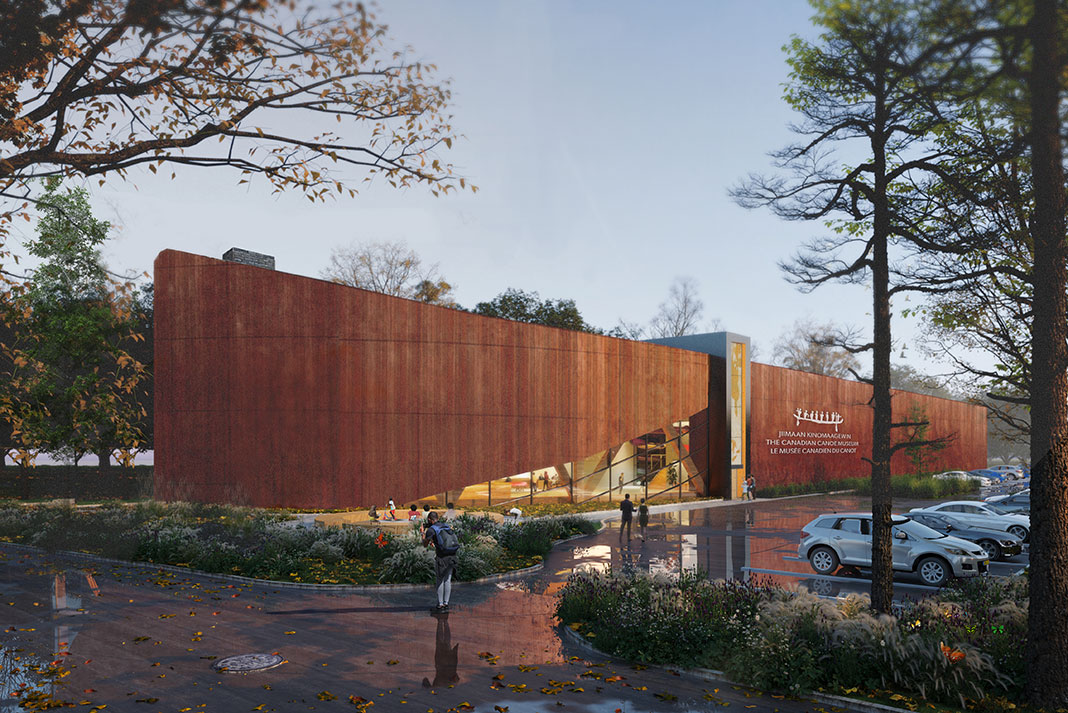
It was during this chaotic time the woodlot between the Parks Canada canal office and a public park on the east shore of Little Lake came back into consideration. “We knew about this property, and always thought it would be an ideal base for on-water activities, but we always understood it to be a flood plain,” explains Ward. After the canal false start, they took a closer look.
As Hyslop says, once it became clear a cooperative Peterborough city council would be willing to part with the land—for the market value of $1.575 million—there followed a process of reaffirming a few priorities that might have been lost sight of in the glint of the canal design.
“When forced to start again, we decided we had to go back to our values.” The core value? Staying within their means and being sustainable over the long term.
The square footage of the new building would be 65,000 square feet, one-third smaller than the canal design. The budget was similarly reduced, from $65 million to $40 million.
The new museum comes together
During a tour of the new museum with Hyslop and Ward less than three months before the springtime grand opening, the site is still very much a work in progress. A tarp covers part of the facade reaching 55 feet above the front door, scaffolding crowds the entrance and the mud around the building makes route-finding a necessity on approach. There remains much to be done, but the pair betray no nervousness. Instead, there is palpable excitement—and even what seems like a sense of relief at how things worked out. The design of the canal site might have gained more attention in architectural digests, but the lower price tag and, especially, the more flexible setting of the Little Lake site let Hyslop and Ward assert with convincing conviction they are in just the right place, literally and figuratively.
Immediately to the right of the western entrance is a fireplace built into the exterior stonework.
“A museum should be a sensory experience,” explains Hyslop. “We wanted visitors to be immediately greeted with the smell of woodsmoke.”
All well and good, but there’s another fireplace on the other side of the wall, inside the entrance.
“The architects said, ‘You guys are nuts. You want a fireplace in a Class A museum environment?’” Hyslop says of concerns woodsmoke and artifacts don’t mix. “We told them we’d figure it out.”
The fireplace they figured out animates a spacious atrium rising to the roof of the museum and serves as a grand entrance hall, but also an indoor space for the indoor/outdoor café, which is licenced for alcohol, caffeine and baked goods. The café’s serving counter slides seamlessly into the admissions counter, which doubles as the canoe rental desk.
“Every room is asked to do two or three things,” says Ward, explaining while the square footage and price tag were reduced, the result is a building “meeting all our needs.”
The first separated space from the atrium is a bright and spacious workshop, which Ward says will host builders-in-residence and be home to restoration work and hands-on workshops for visitors for things like paddle carving.
The ground floor hallway ends at a double door, behind which rests the most significant collection of historic canoes and kayaks on the planet. Walking through the door, it’s impossible not to be struck by the sheer size of the 20,000-square-foot room packed, wall to wall, floor to 25-foot ceiling with five tiers of canoes and kayaks spanning centuries and cultures.
More than 500 crafts lie in steel cradles. Ward points to one canoe, saying it once belonged to Farley Mowat, the author who introduced so many to the terra incognito of Canada’s north. Above it, a canoe donated by singer-songwriter Gordon Lightfoot. It’s not the more famous canary yellow canoe he sang about (that one is upstairs). This one is a cedar canoe; one Lightfoot told Ward he had paddled through thousands of kilometers of wilderness. The sprayskirt snap fasteners underneath the gunwales, patches on the underside of the hull and a railway boxcar sticker on the bow suggest the inspiration for many of Lightfoot’s wilderness-themed songs would have been received in the stern seat of this ordinary-looking hull.
For now, it and the others are wrapped in clear plastic while construction finishes. Ward checks a sensor to note the temperature and humidity levels, factors controlled with help from the $11 million from Heritage Canada for artifact preservation systems. When the museum opens and the dust settles, the canoes will be unwrapped, and the hall will open for scheduled tours. No interpretive plaques, just a feast for enthusiasts’ eyes.
“We didn’t want to rent space off-site for the artifacts,” says Ward. “We wanted to have them under one roof where we could take care of them.” He notes there is room for the collection to grow by 10 percent. At which point Hyslop reminds him there is a moratorium on new acquisitions. They share a look like they’ve been over this before, and we all agree it’s time to go upstairs.
“A museum should be a sensory experience.”
—Carolyn Hyslop, executive director
The exhibition hall is situated above the lofty collection hall, a configuration giving the two-floor museum the height of a four-story building. To get there, climb three flights of stairs, the treads of which were milled from the white ash felled to make room for the building.
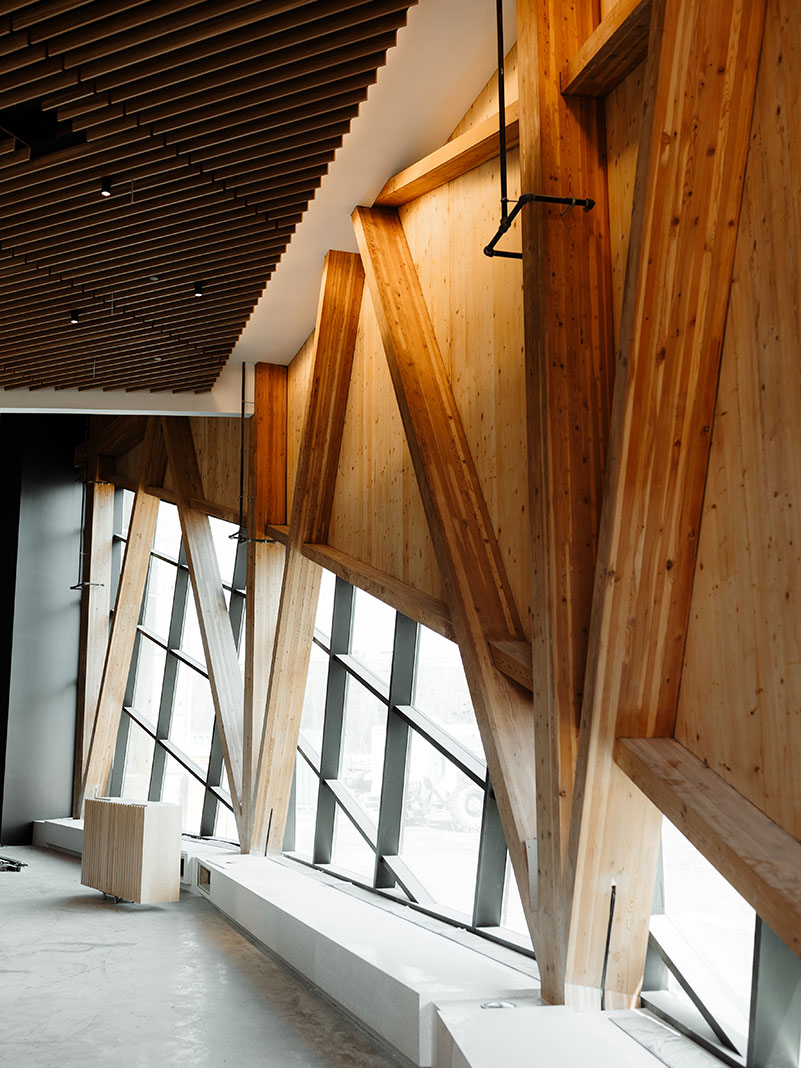
The top floor is home to the library. In what will be a brand-new offering for the museum, it now has space to host researchers who want to get their (washed) hands on the museum’s archive of canoeing-related books, maps and catalogs. More than 1,200 books will be stored here, with rare and antique items available but safeguarded on 1,400 linear feet of shelving in the archives.
Across the hall is the wide opening of the indoor/outdoor event space, future home to weddings, conferences, galas and more. Its wall of windows offers a view of the lake through the treetops. The room will be an important moneymaker, a means to support the collection, which is waiting behind one last set of climate-controlled doors.
In contrast to the airy and expansive collection hall, the exhibit hall strives for intimacy. Within its forest green walls will be six permanent exhibits and a space for temporary displays.
While most exhibits are still being assembled, a feature called The Swirl has already taken shape and catches the eye. It’s a collection of canoes suspended in a circle from the central ceiling. It includes conventional-looking hulls, but also a dugout, birchbark canoe, plastic freestyle kayak, carbon fiber sprint racing hull, Grumman aluminum, early 20th-century courting canoe, solo whitewater boat and more.
“Wherever we go across the country, people take us out to the water,” says Ward. “They say, ‘You think you know what canoeing is in Ontario. Now you’re going to learn what it is here.’ And then we get schooled. There are so many different ways in which canoeing is an important part of lives and cultures. The more you try to pin it down, the more it slips through your fingers.”
Ultimately, the worth of any museum is in the interpretation of the displays. That storytelling material is not yet in place three months ahead of opening, but Ward points to stands of different shapes that will hold not just text but also audio and visual equipment. Over his 27 years with the museum, he’s crossed the country, with an emphasis on visiting the Indigenous communities that can be seen as the origin of almost all the designs in the building. It will be Indigenous voices and faces telling many of the stories taking shape in this room.
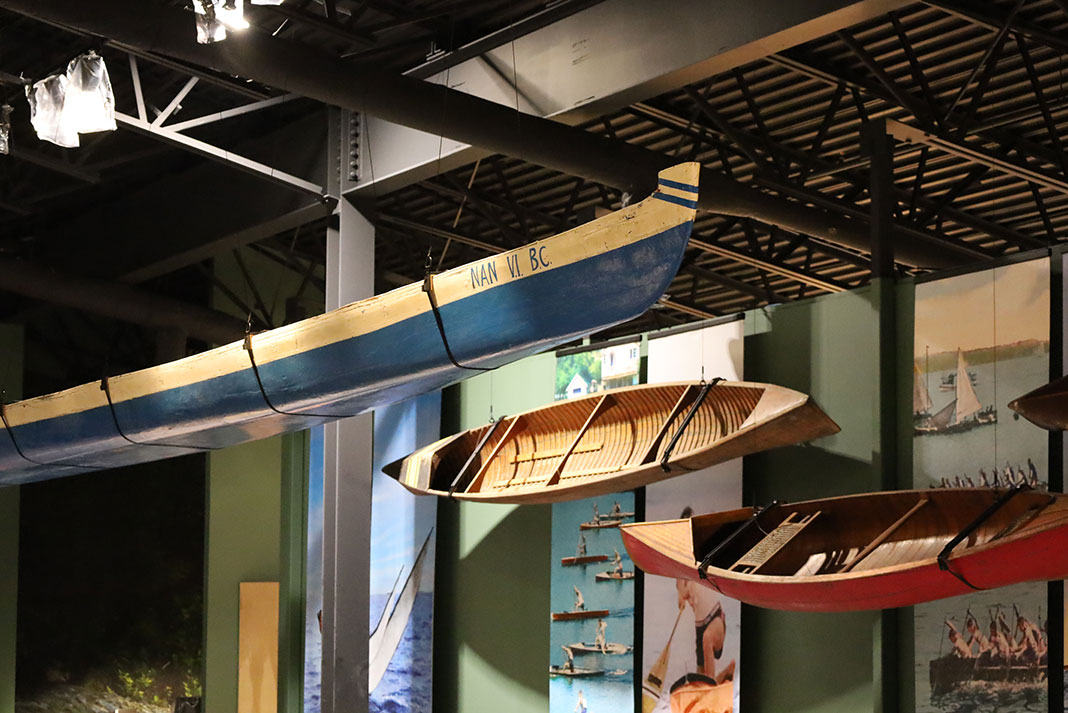
Capturing the diversity of canoeing culture is one of the missions of the museum. The other is promoting it. And this mission will get the biggest boost of all from the move to this five-acre site, with its expanded capacity to let people not just see canoes, but also paddle them.
As dazzling as the canal design was, the waterfront there was the side of a canal. Peter Vooys, program manager since 2002, observes anyone launching a canoe from the museum would have been competing with yachts and motorboats lining up for a ride in the locks.
“We want to be the first step, giving inexperienced people the inspiration, but also the tools, to canoe in the backcountry.”
—Peter Vooys, program manager
At Little Lake, on the other hand, there will be an open lake and a sheltered creek for paddlers to explore. They will take to the water in rented tandem canoes or as part of scheduled 36-foot voyageur canoe tours. They will do it as part of instructional courses, summer day camps and school field trips, or as walk-ons at the end of a private trip to the museum, or on overnight trips to nearby Kawartha Highlands Provincial Park.
It won’t just be on-water activities visitors can expect. There will be workshops, ranging from basic camping skills all the way up to gourmet campfire cooking courses.
“We want to be the first step, giving inexperienced people the inspiration, but also the tools, to canoe in the backcountry,” says Vooys. “We imagine it being a very busy place.”
In addition to diversifying the ranks of canoeists, all these offerings will also diversify the revenue stream for this nonprofit that would like to be as self-sufficient as possible.
Hyslop estimates annual budgets of around $1.5 million, of which two-thirds will come from revenue and one-third from fundraising. At the old site, the ratio was reversed. She projects the exhibits and programs will bring in 87,000 visitors annually, a 2.5-fold increase over pre-pandemic numbers.
Whether it’s admission tickets, program fees, equipment rentals, event bookings, gift shop sales or the café’s annual lease, the site has a promising projected revenue stream that should address a reality identified by Raffan, “It’s relatively easy to get money to build a new building. What’s not easy is not closing it in a few years for lack of funds.”
A collection for all canoeists
When visitors do begin arriving, from Canada and beyond, they will be walking past the sign identifying it as the Canadian Canoe Museum. Ward acknowledges waterways don’t follow national borders, and while Canada has a special relationship with the canoe, it’s not an exclusive one.
Graham Mackereth, founder of Pyranha Kayaks, agrees. A collector himself, with more than 100 crafts of his own, he’s visited the museum three times from his home in England, claiming to be in awe of what has been achieved in Peterborough.
With the perspective of a European collector, he points out almost every nation has its own canoe history. “Ethnic canoes are a worldwide phenomenon. They were important in Europe too, but that was centuries before. In Canada, it was a major part of getting around and close enough in living memory to be appreciated.”
That makes this homegrown effort important on a global scale, says Mackereth. “Canoes are important to all of us, and without somewhere to look after the artifacts, the sport would be in a poor place. It’s the world’s museum, really.”
And it’s about to open its doors.
Ian Merringer is a former editor of Canoeroots magazine and the current managing editor of Ski Canada.
A rendering of the new Canadian Canoe Museum located on the shore of Little Lake in Peterborough, Ontario. The museum has stewarded the world’s largest collection of canoes, kayaks and paddled watercraft over the past 20 years. | Feature photo: Unity Design Studio




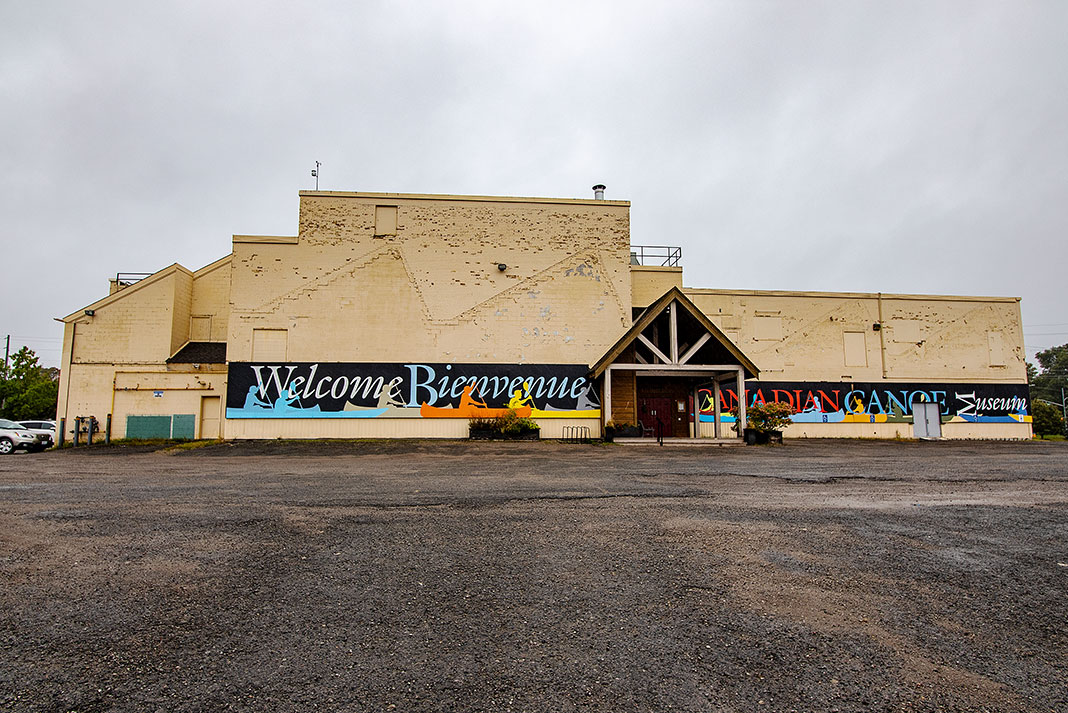
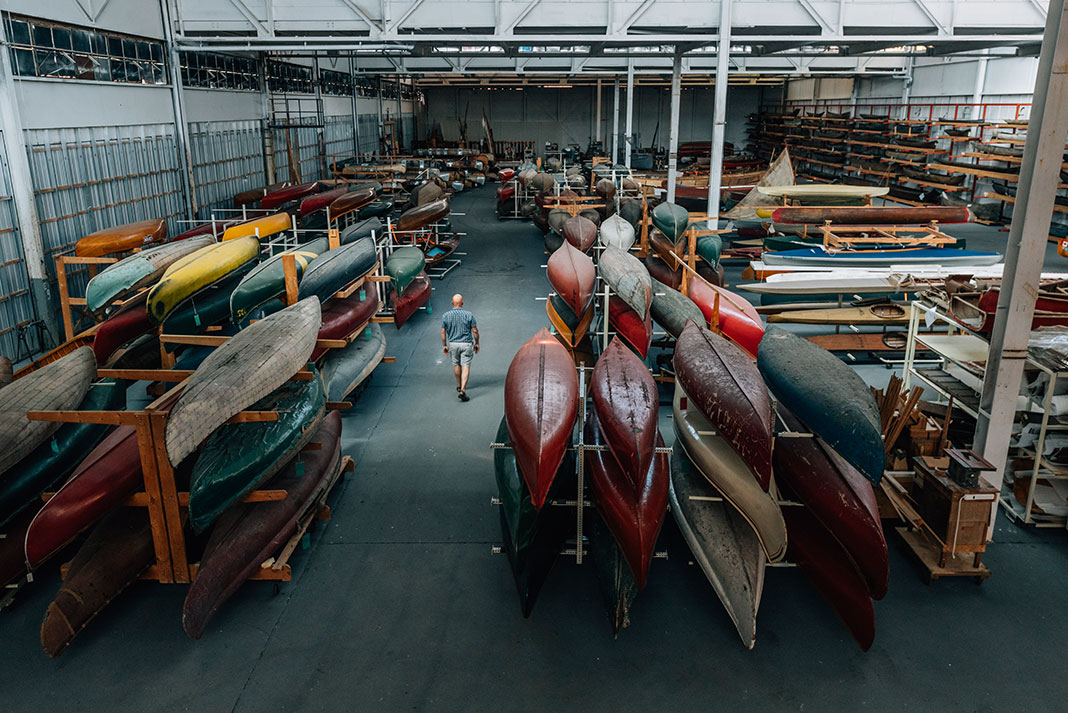
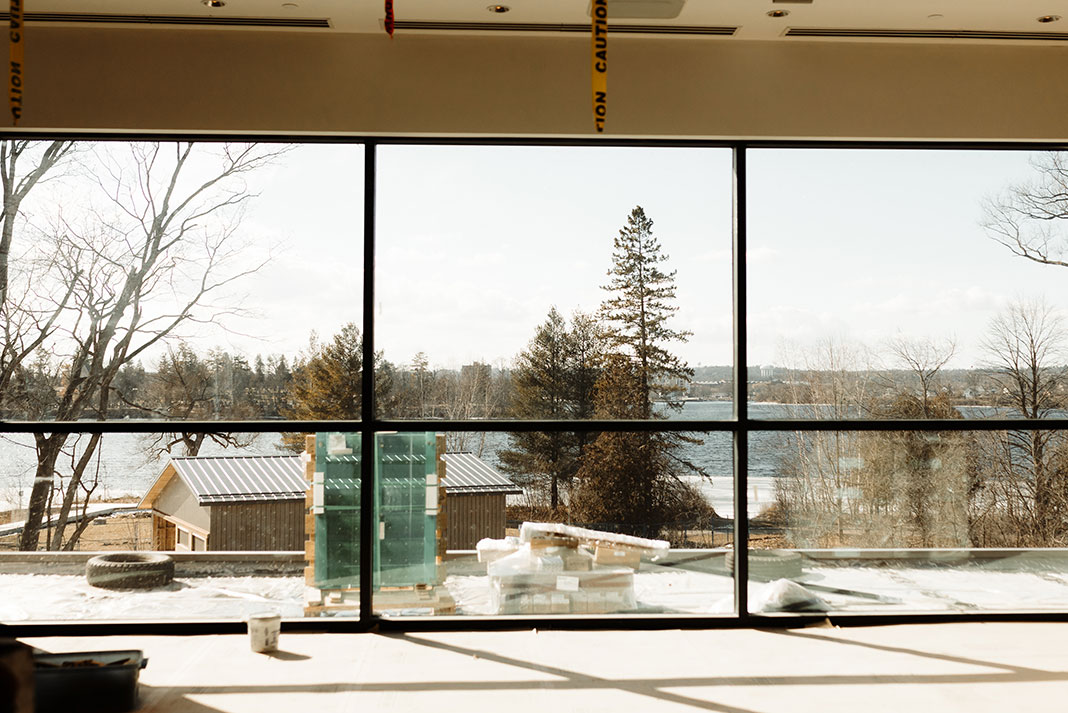
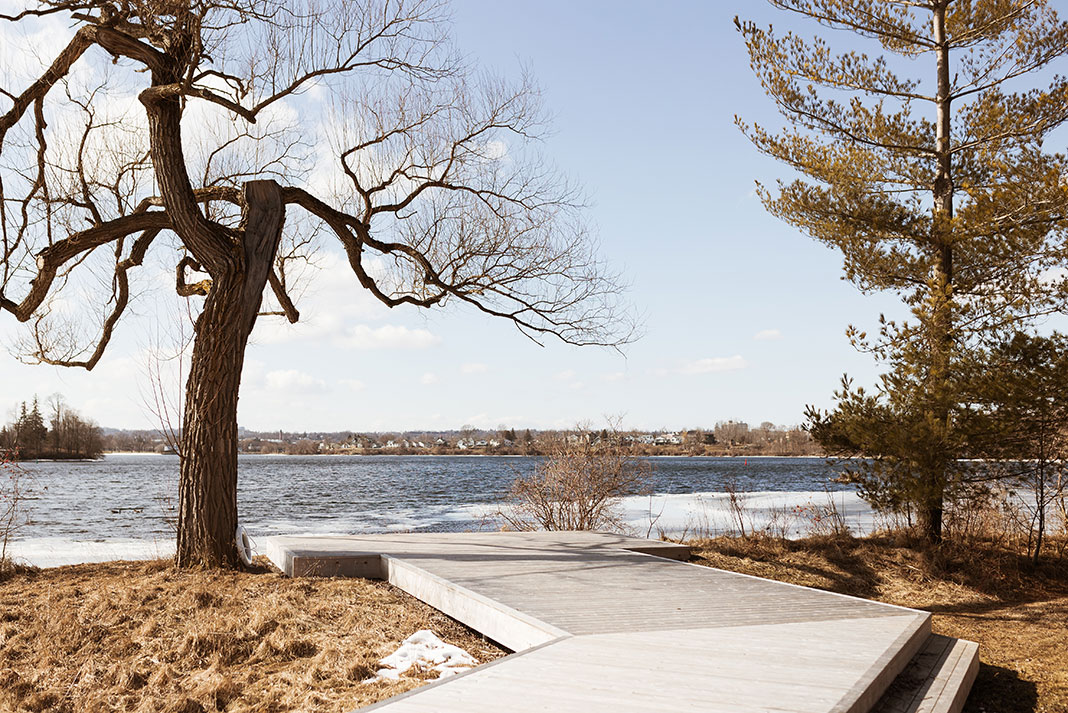

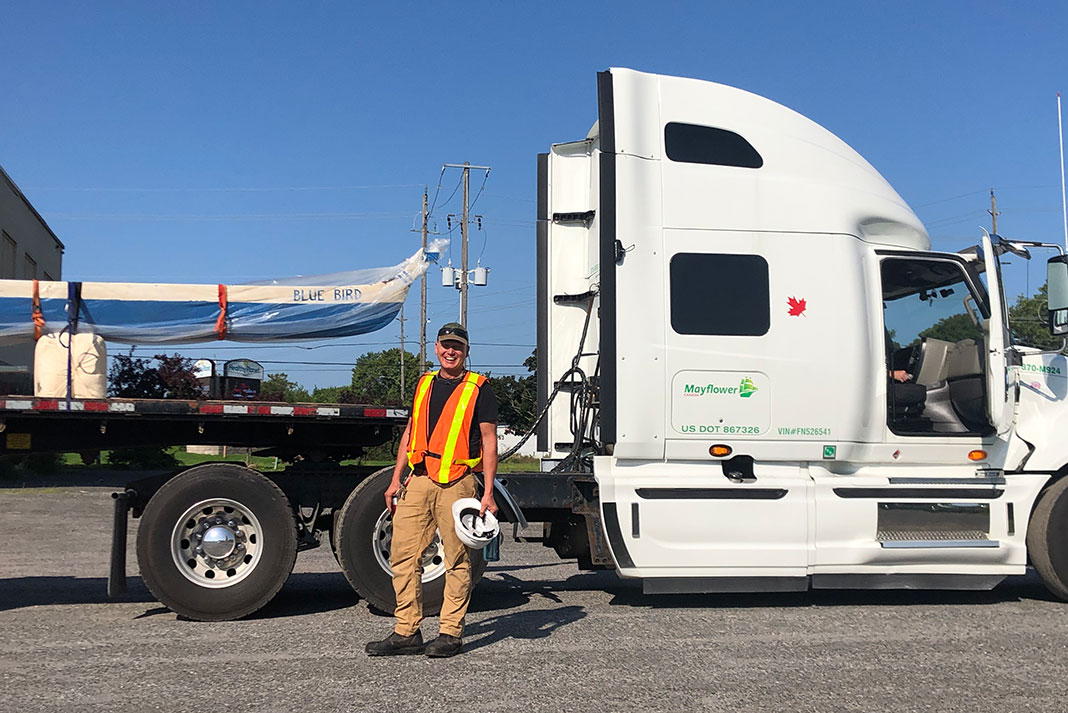

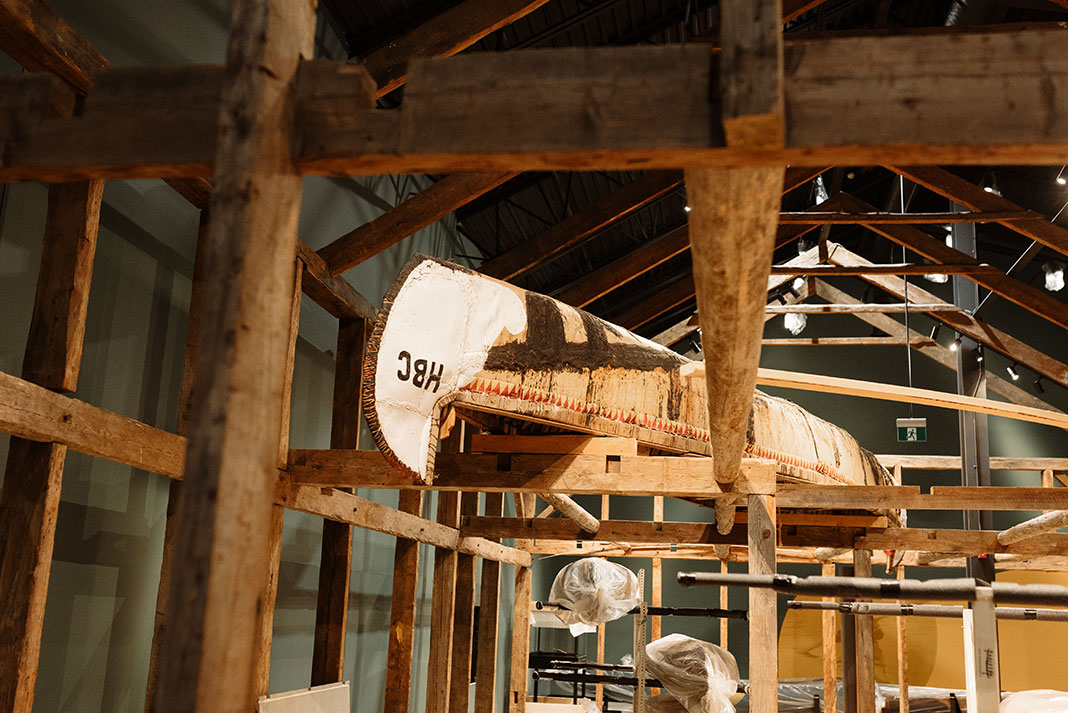
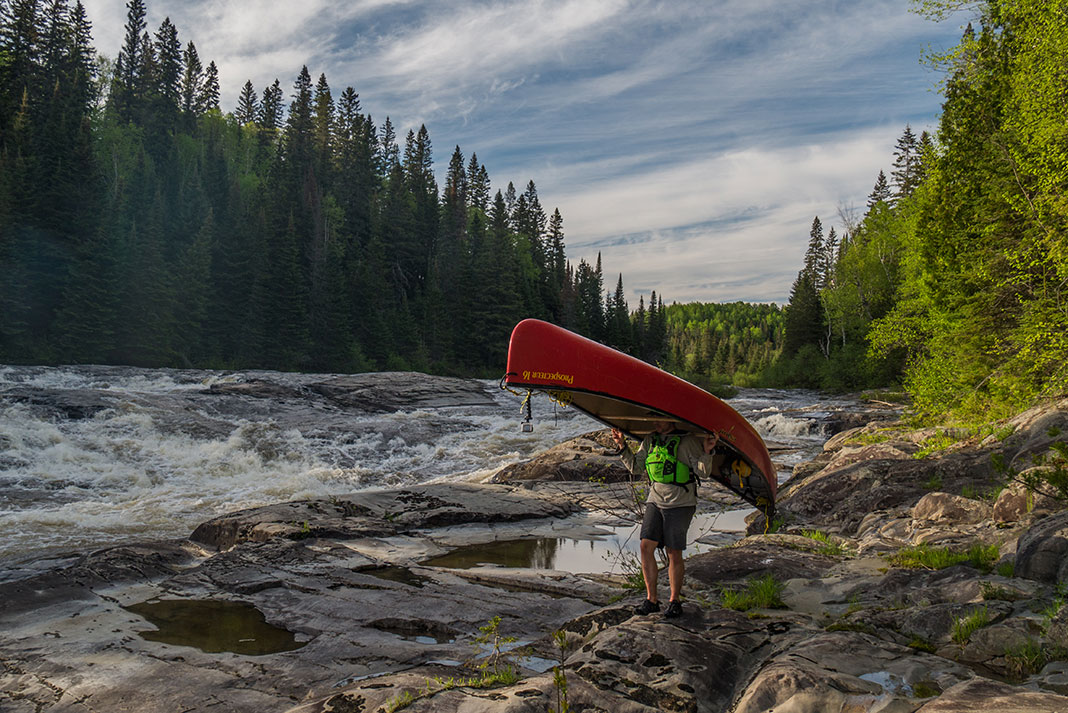
 This article was first published in the Spring 2024 issue of Paddling Magazine.
This article was first published in the Spring 2024 issue of Paddling Magazine. 